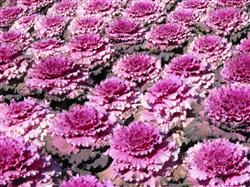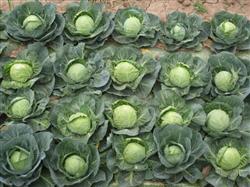How to cultivate kale in open field?

How to grow kale in the open field? Please introduce the planting methods and management methods in detail. The following methods can be referred to for kale cultivation in the open field: Cultivation season: generally in late March to early April in protected areas, planting in the open field in mid-May, harvesting in mid-June. Sowing seedling 1. Sowing: In spring, the sterile fertile garden soil is used for seedling bed soil in protected land, 500g of Lvxinbao biological compound fertilizer or 5kg of fully decomposed organic fertilizer is applied per square meter, the fertilizer is mixed with the bed soil and sieved, and the seed is sown or broadcast after irrigation. When sowing, open shallow furrows about 1cm deep according to the row spacing of 5~6cm, and pay attention to uniform sowing when sowing. After sowing, cover with fine soil about 1cm and cover with plastic film. 2. Seedbed management: keep the soil moist after sowing and keep the temperature at about 20℃. Remove the mulch after emergence, keep the temperature at 15~18℃ during the day and no lower than 10℃ at night. 2~3 leaf stage seedling division, nutrient area 5~6cm square, with the nutrition bowl seedlings do not divide seedlings. When the seedling age is 30~30 days and there are 5~6 true leaves, it can be transplanted. 4. Planting: Fertile loam or sandy loam land should be selected for cultivation of kale. 30~45t of fully decomposed organic fertilizer such as chicken and pig manure should be applied per hectare before planting. After ploughing and soil preparation, ridge 50~55cm wide or small high ridge 1.0~ 1.2 m wide shall be made. Cover film, punch hole planting. Double rows were planted in border culture and single row in ridge culture, plant spacing was 45~50cm, density was 3.75~4.50 million plants/hm2, and sufficient water was irrigated after planting. 5. Management in the shed 1. Intertillage management: after planting and slow seedling, intertill and loosen soil in time, which can improve ground temperature, reduce water evaporation, promote root growth, and eliminate weeds. Generally, intertill 2~3 times before plant ridge closure, with a depth of 3~4cm, and then manually pull out weeds. 2. Fertilizer and water management: kale has strong adaptability. Generally, the first topdressing is carried out after planting and seedling slowing. Urea 15.0 ~ 22.5 kg or decomposed human excrement and urine 15.0~ 22.5 t is applied per hectare to promote stem and leaf growth and improve yield and quality. About 150kg urea is applied per hectare after each harvest. The growth of kale stems and leaves is large, and the consumption of water is also more. After each topdressing, irrigation should be carried out, and the soil should be kept moist frequently. However, the amount of irrigation should not be too much each time. When rainfall is concentrated in summer, attention should be paid to drainage, and no water should be accumulated in the field. 3. Pest control: kale pests and diseases are few, the main pest is cabbage caterpillar, such as early detection with deltamethrin EC 1500~2000 times spray control. 4. Harvest: 25~30 days after planting, 7~8 large leaves grow out, regeneration of heart leaves, can be harvested one after another, can be harvested once every 10~15 days, summer high temperature, leaves are harder, more fiber, poor flavor, should shorten the harvest interval time, reduce the aging degree of leaves. Generally early spring and late autumn leaves texture crisp and tender, good flavor. Click for more cabbage growing techniques Click for more vegetable growing techniques
- Prev

How to grow kale?
How to grow kale? How to manage and control diseases and insect pests? Please give guidance to kale planting methods and management methods can refer to the following techniques: sowing seedlings in mid-late February using protected areas to raise seedlings, about 50 grams per mu of land. Before sowing, pour the bottom water through the seedling bed, and then sow the seeds evenly.
- Next

How to grow pollution-free cabbage?
How to grow pollution-free cabbage? Please introduce in detail the planting methods for pollution-free cabbage cultivation can refer to the following methods: first, varieties select the varieties used for cabbage cultivation, depending on their cultivation purpose and time on the market. Early spring plastic film cultivation in small arch shed often selects early-maturing varieties, such as Zhonggan 11.
Related
- Where is it suitable to grow horseradish in China? it is expected to see the middle altitude horseradish in Alishan.
- How to prevent tomato virus disease reasonably? (Control methods included)
- Many people like to plant towel gourd on the balcony. What are the main points of this method and management?
- What crops can chili peppers be mixed with?
- Fertilization techniques and matters needing attention in Tomato
- What are the grafting techniques for peach seedlings in spring?
- Harm and control methods of root swelling disease of Chinese cabbage
- What are the pests of sweet potatoes? How to prevent and cure it?
- Symptoms, causes and Control methods of navel Rot in Tomato
- The cause of "Cucumber rotten bibcock" in Farmers' planting Cucumber and its Control Plan

